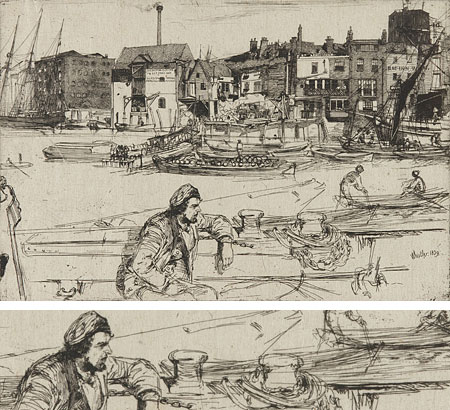
I’ll do a general post about James Abbot McNeill Whistler at some point, but for this one I want to concentrate on his etchings. In the general sense, suffice it to say that if your only familiarity with Whistler is his rather staid profile portrait of his mother sitting in a chair (Arrangement in Grey and Black: Portrait of the Painter’s Mother, commonly known as Whistler’s Mother), you’re missing out on a unique and amazing artist.
Apart from his considerable skill as a painter, he was an astonishingly accomplished etcher and printmaker. Whistler is my second favorite etcher, after only Rembrandt, and that’s saying something. His masterfully atmospheric etchings could capture with equal aplomb the delicate grace of a young girl or the rough textures of the London waterfront.
Etching is a painstaking process. The metal plate (copper in the past, these days steel or aluminum unless you’re rich) is coated with a wax ground, into which the artist draws with an etching needle or other sharp instrument. The plate is then immersed in acid which “bites” (etches) lines into the plate where the wax resist has been removed by the needle. The plate is then prepared, inked and wiped so that the ink only remains in the recessed lines, and then run through a press with a dampened sheet of special (usually soft) paper, transferring the ink to the paper through pressure.
The artist doesn’t truly know what a print (or impression) will look like until going through the entire process. Often the artist must repeat the process and bite the plate again if the lines are not definite enough, or the plate can be ruined if the lines are bitten too far or the resist is corrupted with dirt or pinholes. (All in all though, as painstaking as it is, there is something soothing and appealing about the process. It produces some of the state of “mindfulness” often engendered by craft that requires careful attention.)
The advantage of etching, other than the ability to produce and sell multiple versions of the same drawing, is the beautifully fine line that is possible with an etching needle and the careful biting of a plate. Whistler was a master etcher, and also worked in drypoint, the creation of plates without acid by scratching directly into the surface, producing a coarser but softer-edged line that is sometimes preferred.
His most famous series of etchings is of the banks and docks of the Thames River (image above) in his adopted home of London. (Whistler was an American by birth.) He also produced two wonderful sets of Venice, which he sometimes added to with pastel after they were printed, and a French set.
His images can be heavily rendered in one section of the composition, giving an illusion of solid reality, and dissolve into obvious lines on paper a few inches away. (I just love that effect and the mental shift it produces.)
There is a beautiful but expensive volume, The Etchings of James McNeill Whistler by Katharine A. Lochnan, but there is also a very nice and inexpensive Dover book, Etchings of James A. McNeill Whistler (Dover Art Collections) by Maria Naylor.
The Dover volumes as a whole are wonderfully inexpensive, but image quality often suffers in the inexpensive printing. Etching, however, survives reproduction in books far better than drawing or painting, largely because it is a graphic process to begin with and deals with line, and this book is a bargain for the price (about $13). (Dover also has a terrific and very inexpensive volume of The Complete Etchings of Rembrandt: Reproduced in Original Size by Gary D. Schwartz.)
The link below is to a wonderfull collection of Whitsler’s etchings and drypoints at the Freer Saclker Online Collection of American Art from the Smithsonian.
There is something irresistible and other-worldly about etched lines, and a subtle delicacy that is unmatched in any other drawing medium (except perhaps for metalpoint). In Whistler’s hands, etched lines become things of wonder.

Comments
4 responses to “Whistler’s Etchings”
An electronic catalogue raisonne of Whistler’s etchings is currently being developed as a major research project in Glasgow: information about interesting impressions and fine etchings will be much appreciated!
I own the etching above this could you authenticate it or least tell me you think its correct
I have a Paper gold foil print of the above picture. It is a 5×7 print. I was wondering if you can tell me it’s value? Thank you so much. Tina Buffington
No, sorry.